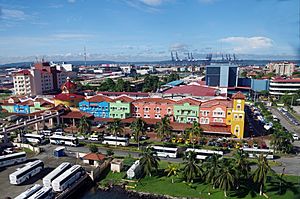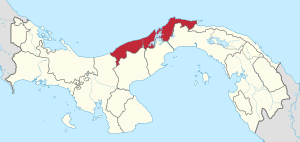Colón Province facts for kids
Quick facts for kids
Colón Province
Provincia de Colón
|
|||
|---|---|---|---|
 |
|||
|
|||

Location of Colón Province in Panama
|
|||
| Country | Panama | ||
| Founded | 1855 | ||
| Capital city | Colón | ||
| Area | |||
| • Total | 4,575.5 km2 (1,766.6 sq mi) | ||
| Population
(2019)
|
|||
| • Total | 294,060 | ||
| • Density | 64.2684/km2 (166.454/sq mi) | ||
| official estimate | |||
| Time zone | UTC-5 (Eastern Time) | ||
| ISO 3166 code | PA-3 | ||
| HDI (2017) | 0.799 high |
||
Colón is a province in Panama. Its capital city is also called Colón. This province covers about 4,575.5 square kilometers. In 2019, about 294,060 people lived there.
Contents
What is Colón Province Like?
Colón Province is known for its busy trade and business activities. It is home to the Colón Free Zone, which is a very large area for international trade. The famous Panama Canal also runs through this province. Many banks and businesses operate here.
But Colón is not just about business! It also has amazing natural places. You can find beautiful coral reefs and thick rainforests. These natural wonders are becoming popular spots for tourists to visit.
History of Colón Province
During the time when Spain ruled Panama, the Colón region was a very important center for trade. Goods and people moved through this area. Many people from Africa were brought to this area to work and contribute to the economy. They were also sent to other Spanish colonies from here.
People of Colón Province
Most of the black population in Panama lives in Colón Province. There are two main groups of black people in Panama.
The first group arrived very early, starting in the 1400s. They came as enslaved people from Africa. Over time, they mixed with Spanish people. This group is known by names like Cimarrones, Afro Colonials, Nativos, Playeros, and Congos. They are considered the first black people of Panama. Afro Colonials kept their own culture but also adopted Spanish customs. They took Spanish names and helped create Panama's unique black population and culture. They became a part of Panamanian and Spanish-speaking society.
The second group arrived later, starting in the 1840s. These were black people from the Caribbean and West Indies. They came to Panama to help build the Panama Railway and later the Panama Canal. Many, especially from Jamaica and Barbados, settled here between 1880 and 1901 to work on the Canal. Many of them stayed in Colón Province. Hispanic Panamanians call this group Afro Antillanos. They have also blended into Hispanic culture while keeping parts of their own heritage. They have influenced Panamanian food and music. For example, people of Jamaican descent helped create Reggae en Español, a type of reggae music sung in Spanish.
How Colón Province is Divided
Colón Province is split into smaller areas called districts (distritos). These districts are then divided into even smaller parts called corregimientos. Since 2018, Colón Province has six districts.
| District | Area (km2) |
Population Estimate |
Population Estimate |
Notes |
|---|---|---|---|---|
| Chagres | 445 | 10,282 | 11,342 | |
| Colón | 1,180 | 218,604 | 253,366 | Contains city of Colón |
| Donoso | 1,627 | 13,165 | 14,798 | Western part of Province |
| Omar Torrijos Herrera | 199 | – | – | Formerly part of Donoso |
| Portobelo | 397 | 9,382 | 10,581 | |
| Santa Isabel | 727 | 3,530 | 3,973 | Eastern part of Province |
See also
 In Spanish: Provincia de Colón para niños
In Spanish: Provincia de Colón para niños



